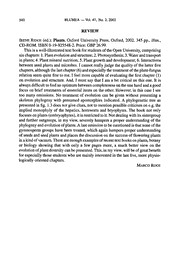
Review PDF
Preview Review
340 BLUMEA Vol.47, No. 2, 2002 Review IRENERIDGE (ed.): Plants. Oxford University Press, Oxford, 2002. 345pp., illus., CD-ROM. ISBN0-19-925548-2.Price: GBP 26.99. Thisis awell-illustratedtextbookforstudentsoftheOpen University, comprising six chapters: 1.Plantevolutionandstructure;2.Photosynthesis; 3.Waterandtransport inplants;4.Plantmineralnutrition;5.Plantgrowthanddevelopment; 6.Interactions betweenseedplants andmicrobes.Icannotreally judge the qualityofthelatter five chapters, althoughthelastchapter(6)andespecially thetreatmentoftheplant-fungus relationseem quitefine tome. Ifeelmorecapable ofevaluating thefirstchapter (1) on evolutionand structure. And, Imust say that Iama bit critical onthis one. Itis always difficulttofindanoptimum betweencompleteness ontheonehandandagood focus on brieftreatmentsofessential itemson theother. However,in this case I see too many omissions. Notreatmentofevolution can be given withoutpresenting a skeleton phylogeny with presumed apomorphies indicated. Aphylogenetic tree as presented infig. 1.3 doesnot give clues, not tomentionpossible criticismone.g. the implied monophyly ofthe hepatics, hornworts and bryophytes. The booknot only focusesonplants (embryophytes), itisrestrictedtoit.Notdealingwithitssistergroup andfurtheroutgroups, in my view, severely hampers aproperunderstanding ofthe phylogeny andevolutionofplants.Alastomissiontobementionedisthatnone ofthe gymnosperm groupshavebeen treated, which again hampers properunderstanding ofseedsandseedplants andplaces thediscussiononthesuccess offlowering plants inakindofvacuum. Thereareenough examplesofrecenttextbooksonplants,botany or biology showing that with only a few pages more, a much better view on the evolutionofplantdiversity canbepresented. This,inmy view,willbeofgreatbenefit for especially thosestudentswhoare mainly interestedinthelastfive, morephysio- logically orientedchapters. MarcoRoos
